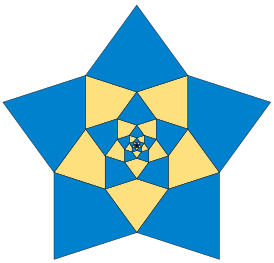Kite (geometry)
| Kite | |
|---|---|
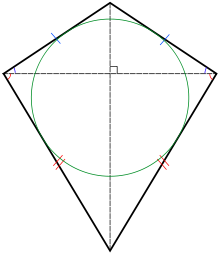 A kite, showing its pairs of equal-length sides and its inscribed circle. | |
| Type | Quadrilateral |
| Edges and vertices | 4 |
| Symmetry group | D1 (*) |
| Dual polygon | Isosceles trapezoid |
In Euclidean geometry, a kite is a quadrilateral with reflection symmetry across a diagonal. Because of this symmetry, a kite has two equal angles and two pairs of adjacent equal-length sides. Kites are also known as deltoids,[1] but the word deltoid may also refer to a deltoid curve, an unrelated geometric object sometimes studied in connection with quadrilaterals.[2][3] A kite may also be called a dart,[4] particularly if it is not convex.[5][6]
Every kite is an orthodiagonal quadrilateral (its diagonals are at right angles) and, when convex, a tangential quadrilateral (its sides are tangent to an inscribed circle). The convex kites are exactly the quadrilaterals that are both orthodiagonal and tangential. They include as special cases the right kites, with two opposite right angles; the rhombi, with two diagonal axes of symmetry; and the squares, which are also special cases of both right kites and rhombi.
The quadrilateral with the greatest ratio of
Definition and classification

A kite is a quadrilateral with reflection symmetry across one of its diagonals. Equivalently, it is a quadrilateral whose four sides can be grouped into two pairs of adjacent equal-length sides.[1][7] A kite can be constructed from the centers and crossing points of any two intersecting circles.[8] Kites as described here may be either convex or concave, although some sources restrict kite to mean only convex kites. A quadrilateral is a kite if and only if any one of the following conditions is true:
- The four sides can be split into two pairs of adjacent equal-length sides.[7]
- One diagonal crosses the midpoint of the other diagonal at a right angle, forming its perpendicular bisector.[9](In the concave case, the line through one of the diagonals bisects the other.)
- One diagonal is a line of symmetry. It divides the quadrilateral into two congruent triangles that are mirror images of each other.[7]
- One diagonal bisects both of the angles at its two ends.[7]
Kite quadrilaterals are named for the wind-blown, flying kites, which often have this shape[10][11] and which are in turn named for a hovering bird and the sound it makes.[12][13] According to Olaus Henrici, the name "kite" was given to these shapes by James Joseph Sylvester.[14]
Quadrilaterals can be classified hierarchically, meaning that some classes of quadrilaterals include other classes, or partitionally, meaning that each quadrilateral is in only one class. Classified hierarchically, kites include the
Like kites, a parallelogram also has two pairs of equal-length sides, but they are opposite to each other rather than adjacent. Any non-self-crossing quadrilateral that has an axis of symmetry must be either a kite, with a diagonal axis of symmetry; or an isosceles trapezoid, with an axis of symmetry through the midpoints of two sides. These include as special cases the rhombus and the rectangle respectively, and the square, which is a special case of both.[1] The self-crossing quadrilaterals include another class of symmetric quadrilaterals, the antiparallelograms.[16]
Special cases
The
Among all quadrilaterals, the shape that has the greatest ratio of its perimeter to its diameter (maximum distance between any two points) is an equidiagonal kite with angles 60°, 75°, 150°, 75°. Its four vertices lie at the three corners and one of the side midpoints of the Reuleaux triangle.[19][20] When an equidiagonal kite has side lengths less than or equal to its diagonals, like this one or the square, it is one of the quadrilaterals with the greatest ratio of area to diameter.[21]
A kite with three 108° angles and one 36° angle forms the

There are only eight polygons that can tile the plane such that reflecting any tile across any one of its edges produces another tile; this arrangement is called an
In non-Euclidean geometry, a kite can have three right angles and one non-right angle, forming a special case of a Lambert quadrilateral. The fourth angle is acute in hyperbolic geometry and obtuse in spherical geometry.[25]
Properties
Diagonals, angles, and area
Every kite is an
As is true more generally for any orthodiagonal quadrilateral, the area of a kite may be calculated as half the product of the lengths of the diagonals and :[10]
Inscribed circle
Every convex kite is also a
For a convex kite with diagonal lengths and and side lengths and , the radius of the inscribed circle is
A tangential quadrilateral is also a kite if and only if any one of the following conditions is true:[28]
- The area is one half the product of the diagonals.
- The diagonals are perpendicular. (Thus the kites are exactly the quadrilaterals that are both tangential and orthodiagonal.)
- The two line segments connecting opposite points of tangency have equal length.
- The tangent lengths, distances from a point of tangency to an adjacent vertex of the quadrilateral, are equal at two opposite vertices of the quadrilateral. (At each vertex, there are two adjacent points of tangency, but they are the same distance as each other from the vertex, so each vertex has a single tangent length.)
- The two bimedians, line segments connecting midpoints of opposite edges, have equal length.
- The products of opposite side lengths are equal.
- The center of the incircle lies on a line of symmetry that is also a diagonal.
If the diagonals in a tangential quadrilateral intersect at , and the
Duality

Kites and
| Isosceles trapezoid | Kite |
|---|---|
| Two pairs of equal adjacent angles | Two pairs of equal adjacent sides |
| Two equal opposite sides | Two equal opposite angles |
| Two opposite sides with a shared perpendicular bisector | Two opposite angles with a shared angle bisector |
| An axis of symmetry through two opposite sides | An axis of symmetry through two opposite angles |
| Circumscribed circle through all vertices | Inscribed circle tangent to all sides |
Dissection
The equidissection problem concerns the subdivision of polygons into triangles that all have equal areas. In this context, the spectrum of a polygon is the set of numbers such that the polygon has an equidissection into equal-area triangles. Because of its symmetry, the spectrum of a kite contains all even integers. Certain special kites also contain some odd numbers in their spectra.[30][31]
Every triangle can be subdivided into three right kites meeting at the center of its inscribed circle. More generally, a method based on circle packing can be used to subdivide any polygon with sides into kites, meeting edge-to-edge.[32]
Tilings and polyhedra
All kites tile the plane by repeated point reflection around the midpoints of their edges, as do more generally all quadrilaterals.[33] Kites and darts with angles 72°, 72°, 72°, 144° and 36°, 72°, 36°, 216°, respectively, form the prototiles of one version of the Penrose tiling, an aperiodic tiling of the plane discovered by mathematical physicist Roger Penrose.[5] When a kite has angles that, at its apex and one side, sum to for some positive integer , then scaled copies of that kite can be used to tile the plane in a fractal rosette in which successively larger rings of kites surround a central point.[34] These rosettes can be used to study the phenomenon of inelastic collapse, in which a system of moving particles meeting in inelastic collisions all coalesce at a common point.[35]
A kite with angles 60°, 90°, 120°, 90° can also tile the plane by repeated reflection across its edges; the resulting tessellation, the
| Polyhedra | Euclidean | ||
|---|---|---|---|
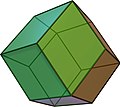 V4.3.4.3 |
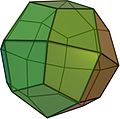 V4.3.4.4 |
 V4.3.4.5 |
V4.3.4.6
|
| Polyhedra | Euclidean | Hyperbolic tilings | |
 V4.4.4.3 |
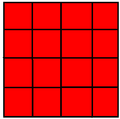 V4.4.4.4 |
V4.4.4.5
|
V4.4.4.6
|
| Polyhedra | Hyperbolic tilings | ||
 V4.3.4.5 |
V4.4.4.5
|
V4.5.4.5
|
V4.6.4.5
|
| Euclidean | Hyperbolic tilings | ||
V4.3.4.6
|
V4.4.4.6
|
V4.5.4.6
|
V4.6.4.6
|

The trapezohedra are another family of polyhedra that have congruent kite-shaped faces. In these polyhedra, the edges of one of the two side lengths of the kite meet at two "pole" vertices, while the edges of the other length form an equatorial zigzag path around the polyhedron. They are the dual polyhedra of the uniform antiprisms.[36] A commonly seen example is the pentagonal trapezohedron, used for ten-sided dice.[16]
| Name | Digonal trapezohedron (Tetrahedron) |
Trigonal | Tetragonal | Pentagonal | Hexagonal | Heptagonal
|
Octagonal
|
... | Apeirogonal
|
|---|---|---|---|---|---|---|---|---|---|
| Polyhedron | 
|

|

|

|

|

|
... | ||
| Tessellation | 
|

|

|

|

|

|

|
... | |
Face configuration
|
V2.3.3.3 | V3.3.3.3 | V4.3.3.3 | V5.3.3.3 | V6.3.3.3 | V7.3.3.3 | V8.3.3.3 | ... | V∞.3.3.3 |
Outer billiards
Mathematician
References
- ^ a b c d e Halsted, George Bruce (1896), "Chapter XIV. Symmetrical Quadrilaterals", Elementary Synthetic Geometry, J. Wiley & sons, pp. 49–53
- MR 0019934
- MR0125489: "It is unfortunate that the author uses, instead of 'kite', the name 'deltoid', which belongs more properly to a curve, the three-cusped hypocycloid."
- MR 1273409
- ^ JSTOR 24953856
- )
- ^ ISBN 978-0-557-10295-2
- ISBN 9781592571833
- ^ a b Usiskin, Zalman; Griffin, Jennifer (2008), The Classification of Quadrilaterals: A Study of Definition, Information Age Publishing, pp. 49–52, 63–67
- ^ JSTOR 41188788
- ^ ISBN 9781285965901
- ISBN 9780195387070
- ^ Henrici, Olaus (1879), Elementary Geometry: Congruent Figures, Longmans, Green, p. xiv
- ^ JSTOR 40248098
- ^ MR 4286138; see also antiparallelograms, p. 212
- S2CID 250436895
- MR 2990945
- ^ Ball, D. G. (1973), "A generalisation of ", S2CID 125396664
- S2CID 126325288
- S2CID 203042405
- ISBN 9780471667001
- S2CID 123579388
- arXiv:2303.10798
- ISBN 9780867204759
- ^ "OC506" (PDF), Olympiad Corner Solutions, Crux Mathematicorum, 47 (5): 241, May 2021
- S2CID 250434576
- ^ a b c Josefsson, Martin (2011), "When is a tangential quadrilateral a kite?" (PDF), Forum Geometricorum, 11: 165–174
- S2CID 125355481
- Zbl 0736.05028
- MR 2501347
- S2CID 12228995
- MR 1255846
- ISBN 978-1-938664-27-4
- MR 4414332
- ^ a b Grünbaum, B. (1960), "On polyhedra in having all faces congruent", Bulletin of the Research Council of Israel, 8F: 215–218 (1960), MR 0125489
- S2CID 123859584
- S2CID 2255628
- S2CID 119146537
- MR 2562898
External links
- Weisstein, Eric W., "Kite", MathWorld
- area formulae with interactive animation at Mathopenref.com






































